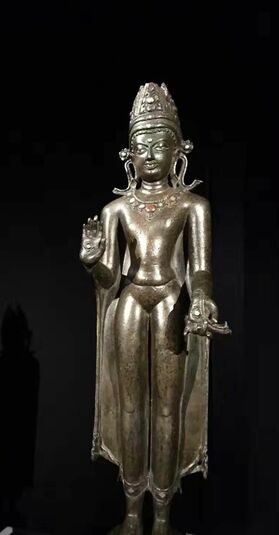
Item: Shakyamuni Buddha - (Standing Sculpture)
| Origin Location | Northern India |
|---|---|
| Date Range | 1000 - 1099 |
| Lineages | Buddhist |
| Size | 40cm (15.75in) high |
| Material | Metal, Copper Inlay, Silver Inlay |
| Collection | Private |
Classification: Person
Appearance: Monastic
Gender: Male
Shakyamuni Buddha wearing a crown.
Formerly from the collection of Jean-Louis Melchior Sonnery de Fromental (1920-1995), acquired 1960s by repute, this standing crowned Buddha is the epitome of grace, energy and strength that can be found among the bronze sculpture of the later Pala-sena school of northeast India. In particular there are many close comparable examples in the Patna museum in India which houses more then 150 like sculptural works that were excavated in Kurkihar in the Gaya region of present day Bihar.
Thus, this sumptuous example of a sculpture with silver inlay, one of the few in private hands, has become known as the Kurkihar Buddha. Cast at a time when tantric Buddhism had become pronounced in India the iconography of the crowned figure is further emblematic of concepts found in the yogatantras in which there was a unification of the Buddha in his sambhogakaya and nirmanakaya nature, wherein Shakyamuni in the Akanishta Heaven was crowned by the Buddhas of the ten directions and recognised as the cosmic Buddha Mahavairochana. Here Shakyamuni is no longer viewed simply within the guise of the historical Buddha, but rather he is transformed into the earthly emanation (nirmānakāya) of the dharmakāya, in the form of Vairochana. From an early period, the concept became widespread in South Asia, Tibet, and Central Asia, and was closely associated with the ideal chakravartin, a wheel-turning king who rules effectively and with compassion and was closely associated with the image of the crowned and adorned Buddha.
These ideas were particularly prevalent in Tibet’s own assimilation of Buddhism, which from the late 8th century through to the 13th century was in close contact and relation with the masters and pundits of India.
D.P. 6-2018
Belonging to a group of Pala sculpture unearthed from the Kurkihar area of North India in the early 20th century is this crowned Buddha. Narrative based, inspired by the life story, with one face and two arms, in a standing posture, with the legs together, Shakyamuni Buddha holds the right hand up with the palm facing outward. The proper left hand is held lower and gently grasps an edge of the mendicant robe. The two hands have the unique characteristic of webbing between the fingers. An interpretation of the hand gestures would suggest that the right is held up, as a sign of fearlessness, to indicate that there is a path towards freedom from suffering. The left hand holding the robe indicates that the path is to follow the example and teachings of the Buddha.
Uncharacteristically, but orthodox according to scripture, he wears a tall three pointed crown (a gift of the heavenly gods). In addition, there are flower ornaments, ribbons and earrings. A short choker necklace is worn around the neck. The palms of the hands are marked with auspicious symbols and likewise the lower front hem of the garment. Aside from the crown and the marks on the palms the additional ornamentation is of a later development in Buddhist imagery relating to the Mahayana sutra literature and possibly with some Tantric Buddhist influence popular from the 7th and 8th centuries onward.
The eyes, lips and some of the ornamentation is inlaid with alternating silver and copper. The two feet aligned, he stands atop a small double lotus base.
The true context of the sculpture is not known nor has it been determined if the image is part of a larger set or narrative production. It is possible that the tall and narrow character was intended for an architectural niche in a temple or alternately a personal home shrine.
The body is well proportioned, long and lean, with some exaggeration in the legs based on the textual sutra descriptions of a buddha's form following the thirty-two major and eighty minor marks, physical characteristics, of a universal monarch. The fingers are well articulated and the composure and expression calm and meditative. There is almost no awkwardness to distract the eye except for the slightly shorter ribbon on the right side, level with the ear, and the foreshortened peak of the central point of the crown atop the head.
The overall condition of the work is exceptionally good with little damage, loss or obtrusive abrasions. Some overall pitting is observed spread evenly across the surface, although hardly noticeable on an object of this age. Sculpture such as this are rare outside of their homeland of manufacture, modern day Bihar, and comparables for comparison must be found in the museums of North India. Dated to the 10/11th century, this superb work of art is remarkable for its beauty, size and condition, a true masterwork of the Kurkihar style of sculpture.
Jeff Watt 10-2019
(See Christie's 1996, HAR #20011).
Provenance: Collection of Jean-Louis Melchior Sonnery de Fromental (1920-1995), acquired 1960s, by repute.
Exhibition: RMA Masterworks, January 28th, 2021
Thematic Sets
Shakyamuni Buddha: Retracted Genitalia
Collection of Zhiguan Museum of Fine Art
Collection of Zhiguan (Sculpture)
Shakyamuni Buddha: Wearing a Crown (Crowned Buddha)
Shakyamuni Buddha: Standing Sculpture
Collection of Zhiguan Museum of Fine Art (RMA 2019)
Sculpture: Style Names, Region & Artist
Shakyamuni Buddha: Wearing a Crown (Standing)
Sculpture: Kurkihar Style





